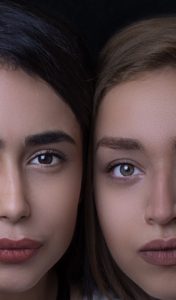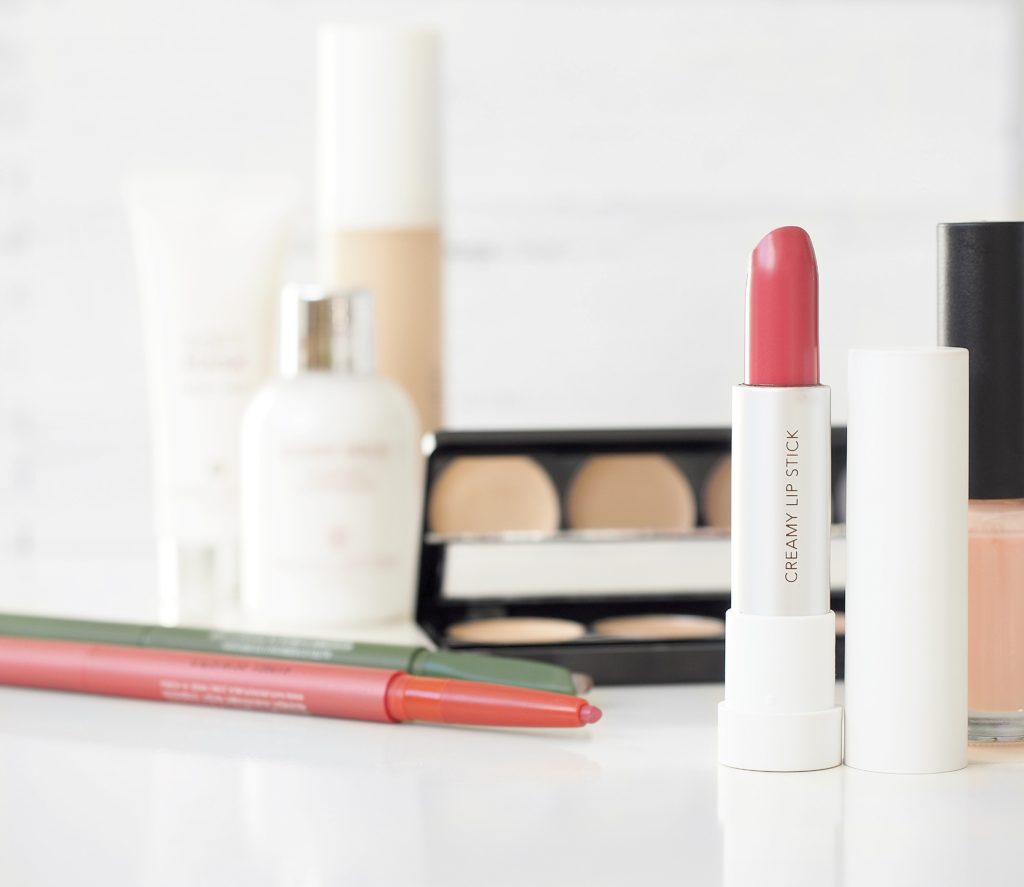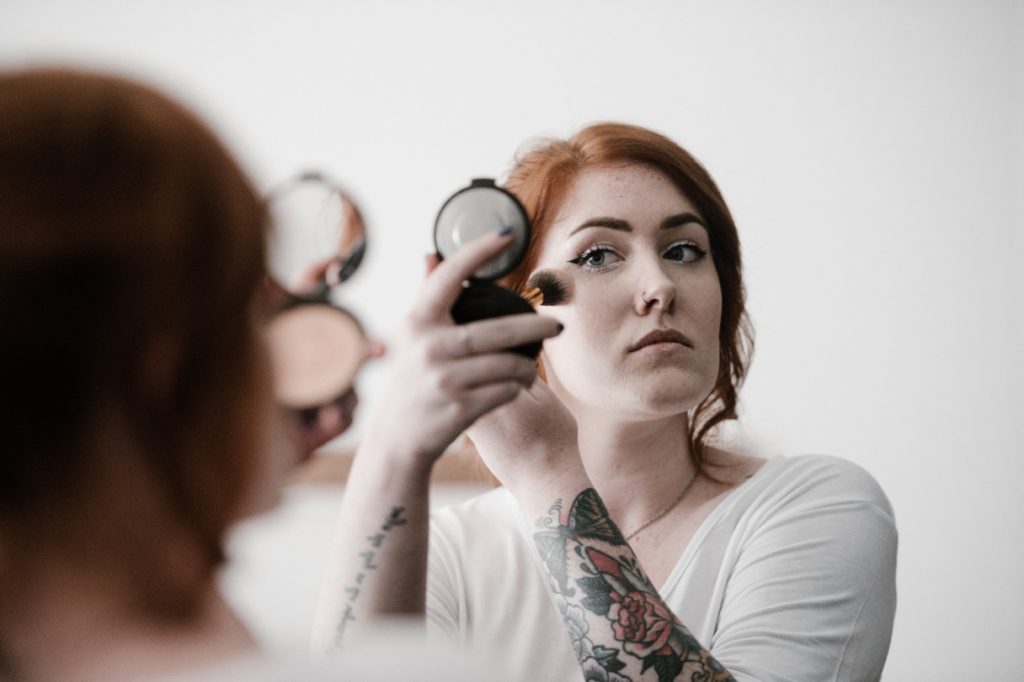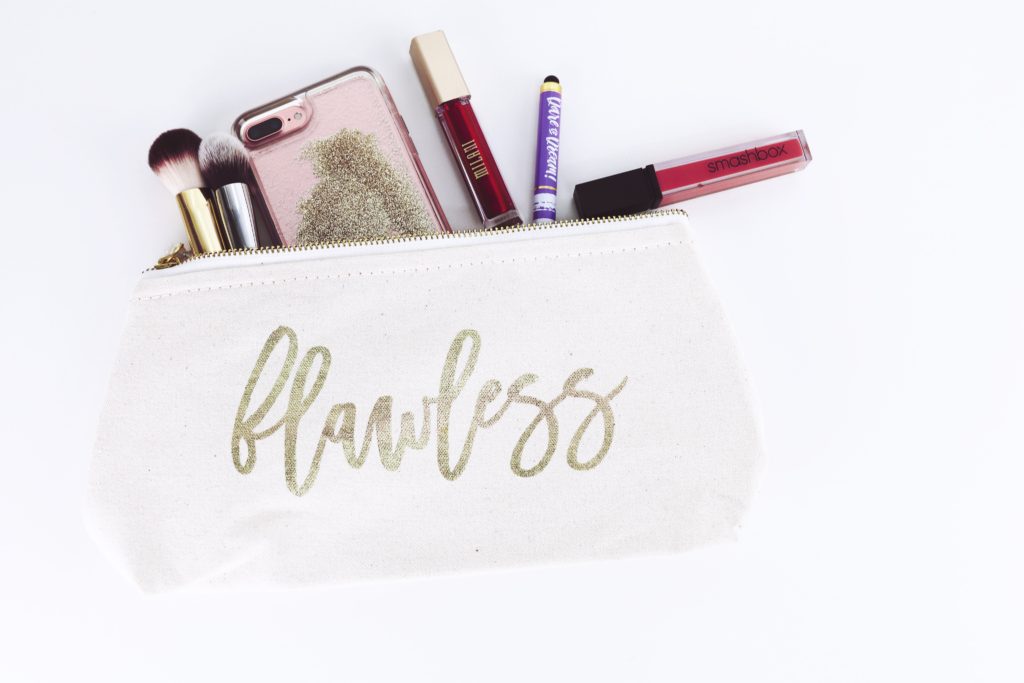Table of Contents

- Introduction
- General principles
- The many reasons you should practice in advance
- What to bring (and not bring) to the gig
- Conclusion
At right: Examples of subtle makeup that would be fine for background acting: note the even skin tone, subtle eyeshadow and mascara, and subdued lipstick colors. Photo by Hadis Safari via Unsplash.
Introduction
If you’re reading this, I’m going to guess you got hired as a background actor a/k/a extra. Congratulations! And the casting agency told you to show up “makeup ready” or “camera ready” but didn’t provide any additional guidance, so you’re trying to figure out what that means. This article will describe what’s worked for me. (For the purpose of this article, I’m assuming you already have some experience selecting and applying makeup, and own at least the essential products ー foundation, lipstick, etc. If this isn’t the case, I recommend starting with makeup tutorials on YouTube ー use search terms like neutral, natural, professional, etc.)
I’ve been a background actor on about 40 TV shows and movies over the past couple of years, sometimes in a few different roles within each show. When I started, I was not an experienced makeup user, but I’ve spent a lot of time practicing, and trying to get a sense of what the shows’ makeup departments are looking for, and now I think I have a good handle on it. I can tell because most of the time, when the show’s makeup artist is checking everyone, he or she looks at me and just says “fine for makeup” (or words to that effect) and checks my number off on their list ー meaning that they don’t feel the need to change anything. It’s very gratifying to go, in less than two years, from feeling like a makeup novice to having professional makeup artists approve your work, including one who told me, “You did a lovely job on your makeup”!
And I know they’re not just approving everyone, because sometimes they do want to adjust other people’s looks. It’s not tragic to have a makeup artist add to your makeup ー and it’s inevitable that it will happen occasionally, because it’s impossible to predict exactly what each artist or show will want ー but if you can arrive wearing makeup they like, it saves time for everyone, and you can feel comfortable and confident in your makeup all day.
Below, I’ve listed everything I can think of that I take into consideration when striving to be “makeup ready” for a background acting job. These guidelines have been working for me, and I hope you’ll find them useful too.
General principles
Look modern, but not trendy
Makeup trends change, just like fashion trends change. It’s good to have at least a general sense of makeup styles from different eras, to know what the show’s makeup artists are likely to want (or not want) based on the time period of the show. If you’re an experienced makeup user who’s gotten into the habit of doing your makeup a particular way for years or decades, I recommend perusing modern makeup products and trends if you haven’t in a while. You could be doing a vintage look without even realizing it! (This is a good skill to have if you’re cast in a period piece, but you should know modern styles too.)
That said, you don’t want to be too trendy, and wear a product or style that’s so avant-garde viewers will be able to identify which product, year or “influencer” your look originated from. When in doubt, think “timeless beauty.”
Color choice
Avoid extremely bright and bold colors that are likely to jump off the screen ー you’re called “background” for a reason. Take a cue from whatever instructions you received about clothing: if they said “no red shirts” or “no neon colors,” they probably won’t like red lipstick or neon eyeshadows either.
Lipstick is the color they’re most likely to be concerned about ー I’ve been told “bring lipstick options.” Own at least a few in whatever colors look subdued and professional on you. I usually wear mauve, berry, or rosy pink shades.

Skip the sparkles
As of this writing, reflective highlighters are popular. I recommend avoiding these. The same goes for any other makeup (such as eyeshadows) that’s noticeably shiny, glittery, sparkly, etc. I haven’t had any complaints about eyeshadows with a slight shimmer, but keep it subtle.
Keep it neat and neutral
Your main goal should be to enhance your own features (or conceal flaws), so that your face looks its best. You want people to notice how nice you look, not how your makeup looks. When I’m doing my makeup before an acting gig, I think about how I would do it for a job interview at a conservative company: polished and a bit fancier than “everyday” makeup, but subdued.
Look for visual references
If you’re booked on a show where at least some episodes have already aired, look online for images or videos from the show, and see if you can glean anything about the actors’ makeup. Does everyone look glam, natural, or somewhere in between?
You can also look for images of your role on other shows. For example, if you were cast as a doctor, look for scenes from any recent medical drama to see what TV doctors typically look like. Note that I said TV doctors, because for this purpose, that’s more important than what real doctors look like. Whatever character you’re portraying, you want to look like an idealized, TV version of that character. Such is the world of entertainment.
Look like your photo
All that said, remember that you most likely got cast based on a photo or set of photos that you submitted or that were on file at the casting agency. They’ll be surprised if you show up looking like you’ve had a complete makeover and look like a different person. When it comes to a background actor’s look, consistency is one of the most important attributes.
Practice applying and wearing your makeup in advance, if possible

Practice applying
You’re most likely to have a “good makeup day” on the day of the gig if you carefully practiced your complete look (using all the exact products you’re planning to use) on one or more days before the gig. When you’re rushing to get ready for a 6 AM call time is not the time to find out that a makeup item:
- is difficult to apply and you wish you had practiced more;
- is dried out and unusable (which unfortunately can happen even in an unopened package!);
- just isn’t the color you expected (this is very common);
- is incompatible with another product, either by formula (for example, sometimes an oil-based product and a water-based product get patchy when layered together) or by color (for example, a warm pink and a cool pink can look odd together); or
- (worst of all) causes an allergic reaction.
Practice wearing
And it’s not enough to put on the makeup, see how it looks, then immediately take it off. I recommend wearing the makeup as you go about your daily activities, for at least a few hours, or all day if possible. See how it looks and lasts in different weather and lighting conditions. Remember that shoot days often stretch to 10, 12, even 14 hours. While there’s probably no makeup that fully lasts and is comfortable for that length of time, if one of your products is especially poor for long-term wear, you want to know before you rely on it for a gig.
When you’re on set is not the time to find out that a makeup product:
- isn’t waterproof, and ran due to sweat, rain, or even fog;
- faded;
- darkened or changed color. This can happen with some blushes and even foundations: they get darker and/or more orangey as you wear them, which I’ve read is due to oxidation (the same reason apples and potatoes turn brown). Lipsticks can also change and darken over time.
- moved (such as eyeshadow flaking onto your cheeks, or lipstick bleeding);
- looks different than expected in different lighting. For example, I have a bronzer which seems invisible in indoor light, but looks very sparkly in sunlight.
- is itching or irritating your eyes or skin. You don’t want to spend the day with red eyes, an itchy face, or stinging lips!
- stains your skin (a potential problem for the next day’s gig!) or
- is causing you to worry and wonder if there’s a problem. If you’ve worn the makeup before and can feel confident it looks fine, you’ll be able to concentrate on the shoot (or enjoy chatting with other background actors in holding), instead of feeling stressed and wanting to check your mirror.
What to bring (and not bring) to the gig

(Photo for decorative purposes only; I’m not suggesting you bring these exact items!)
You don’t need to bring a lot. I usually bring a few makeup items in a small makeup bag, but it’s very rare that I’ve been asked to apply or reapply anything once I’m there. Usually the makeup artist or a PA (production assistant) will instruct lipstick wearers to keep their lipstick with them for touch-ups, and a couple of times I’ve been asked to apply more mascara or to powder my nose, but that’s about it. So I recommend bringing:
- lipstick in a small case;
- a powder compact, and a brush, sponge, or whatever you use to apply it;
- a small mirror, if there isn’t one in your compact;
- anything else you think they might want more of or that you’ll need to touch up;
- anything else they specifically requested (such as lipstick options); and
- makeup remover, if there’s a chance they might apply special-effects makeup, vintage-style makeup, or anything else you won’t want to wear home. I’ve had it happen that I wanted to take off my makeup at the end of a shoot, but the makeup department already went home, taking their supplies with them, and there was no makeup remover available.
I recommend against bringing anything that you’d be very upset to lose, such as an expensive eyeshadow palette. Holding areas are often crowded, and at the end of the day when everyone’s tired and rushing to pack up and leave, it can be easy to lose or forget a makeup item in the whirlwind of people and belongings.
Conclusion
I hope this was helpful! If you’ve had experience with makeup for background acting, whether as an actor, makeup artist, casting director, or anything else, please feel free to leave a comment with your thoughts. (I trust that you won’t violate any NDAs though!) Break a leg on your gig!
